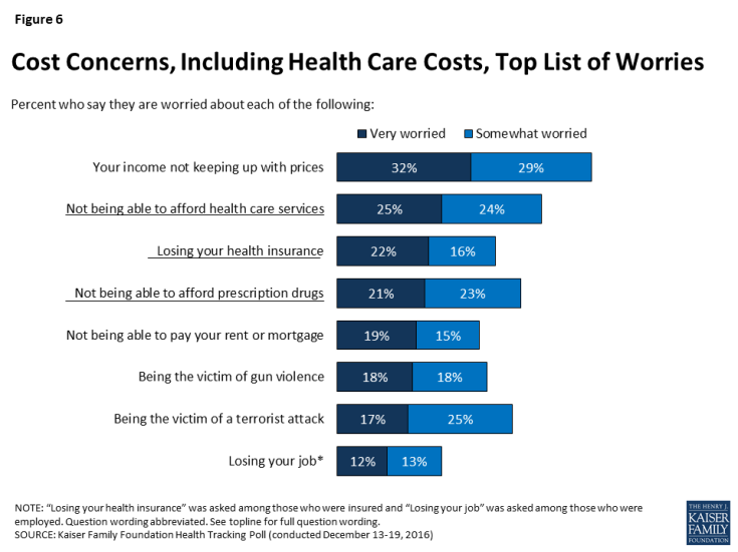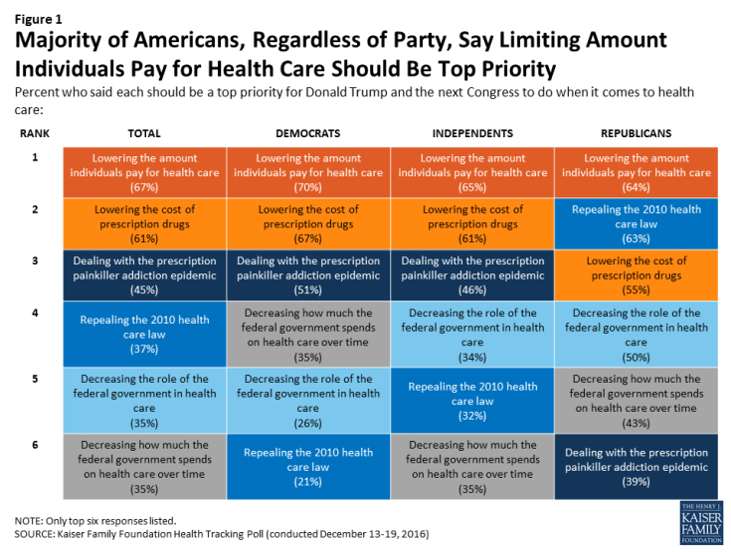
Health care costs are out-of-reach for more Americans, among both people who have insurance through the workplace or via health insurance exchanges.
The first chart illustrates the growing healthcare affordability challenge for American health consumers, discussed in a data note to the Kaiser Family Foundation Health Tracking Poll in March 2017.
In 2017,
- 43% of consumers found it difficult to meet the health care deductible before insurance would kick in
- 37% of consumers found it difficult to pay for the cost of health insurance each month
- 31% said it was difficult to pay for copayments for doctor visits and prescription drugs.
A key health economic reality: the Foundation (KFF) found that people in poor or fair health had a tougher time paying their share of healthcare costs compared with people in good or excellent health. Not surprisingly, more people with lower incomes (less than $40,000 a year) had trouble paying medical bills in the past year, and more of these people also put off getting health care.
 In the scenario of facing an unexpected medical bill of $500, only 48% of insured people (18-64 years of age) said they could pay it in full at the time of service. 20% of insured consumers would put the bill on a credit card and pay it off over time. 18% of insured people would not be able to pay the bill at all. 7% would take out a loan (from a bank, friends or family, or a payday lender) to cover the $500 medical expense.
In the scenario of facing an unexpected medical bill of $500, only 48% of insured people (18-64 years of age) said they could pay it in full at the time of service. 20% of insured consumers would put the bill on a credit card and pay it off over time. 18% of insured people would not be able to pay the bill at all. 7% would take out a loan (from a bank, friends or family, or a payday lender) to cover the $500 medical expense.
Take a look at the second chart capturing U.S. consumers’ top worries. Among Americans’ top 8 worries, three deal with personal health economics:
- 49% are worried about not being able to afford health care services
- 44% are worried about not being able to afford prescription drugs
- 38% are concerned about losing their health insurance.
Healthcare cost concerns trump worries about terrorism or being a victim of gun violence. The thought of losing health insurance is more troubling than the concept of losing one’s job.

Health Populi’s Hot Points: 29% of health consumers said that paying medical bills was a struggle in the past year, based on KFF’s Health Tracking poll conducted in February 2017. For them, health care costs had an impact on their families.
The third chart is a health care kumbaya, illustrating that most Democrats, Independents and Republicans alike say lowering the amount individuals pay for health care should be the top priority for health reform legislated by President Trump and Congress. A close second issue is lowering the cost of prescription drugs, among Democrats and Independents, and for Republicans the #3 health reform issue (repealing the ACA was #2 for them).
As the second draft of a Trumpcare/Ryancare reform plan emerges during the week of 24th April 2017, policymakers should listen to the voters and ensure that the family value of cost-fairness and health equity — regardless of whether one is sick or healthy — are baked into a new-new health plan.




 Thank you, Trey Rawles of @Optum, for including me on
Thank you, Trey Rawles of @Optum, for including me on  I was invited to be a Judge for the upcoming
I was invited to be a Judge for the upcoming  For the past 15 years,
For the past 15 years,